2004 VOLKSWAGEN GOLF brake light
[x] Cancel search: brake lightPage 288 of 444

miles
can b e gradually in creased to
th e maximum vehicl e s
peed or maximum
permissibl e engin e speed (rpm ).
Breaking in tires and brake pads
Durin g the fir st few h o u rs of dri ving, the g ine 's inte rnal fric tion is hi gher than it will be
l a te r w he n a ll th e m ovin g part s have been bro ke n in.
For the sake of environment
th e eng in e is bro ke n in gentl y, the lif e of the engine will be in creased and it s oil co nsumption
New tires should be broken in carefull y for the fir st miles (560 km). New brake
pads b e broken in carefu lly for the first miles (240 km).
Durin g th e fir st miles km l. you can
c ompe nsate for the reduced brak ing effect by apply in g m ore press ure th e brake pedal.l fyo u
need to make a n em ergency slOp, the brak ing
di sta nce will b e longe r w ith new brake pads than
wit h brake pads wh ic h have been b roke n in.
WARNING
New tires and brake pads do not provide imum gri p, control o r braking
(cont;n ued)
To reduce the ri sk of losing a
miles
New brake pads do not have th e best pin g power for the fir st km) and must be broken in. can compe nsate for the s lightly reduced braking effect b y applying more pressure on the brake pedal.
N eve r follow other vehicles to clos ely or put yours elf into other situati on s that might require sudden, h a rd braking especially when the brake pads have not been broke n in.
12 Driving and protecting the environment
Page 289 of 444
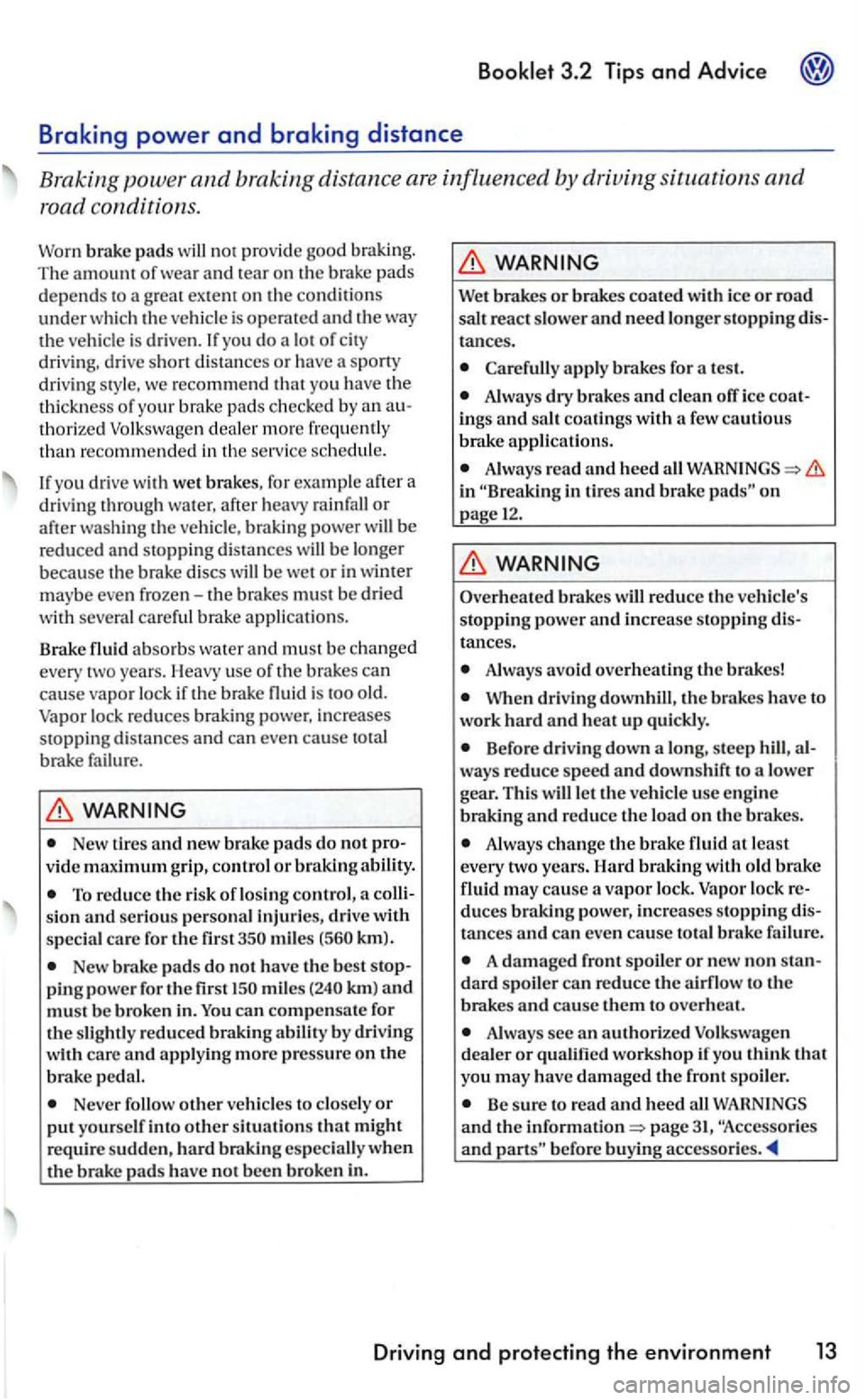
Booklet 3 .2 Tips and Advic e
recommend that you have the
thi ckne ss of your brake pads checked by an au
t horized Vol kswagen dealer mo re fre quent ly
t h an recommende d in the serv ice sched ule.
you drive with wet brakes, for example afte r a
dri ving through water, after heavy rainfall or after washing the ve hicle, braking power be
reduced and s to ppin g distances will be longer
because the brake discs will be we t or in winter mayb e eve n frozen-the brakes must be dried
with several ca re ful brak e applicatio ns.
Brak e fluid absor bs water
and must be changed
every two years. Heavy use of the brakes can cause vapor lock if the brake fluid is too old.
Vapor lock redu ces braking power, increases
stopping distances and ca n even cause total
brake failure.
New tires and new bra ke pads do no t pro
v id e m aximum gri p, control o r b raking abil ity.
To red uce the risk of l osi ng control, a s io n an d se rio us perso nal injuries, drive with
specia l ca re for the first 350 miles (560 km).
New brake pads do not have th e best sto p
ping power for the fir st ISO mile s (240 km ) and
m ust be b roken in. can compensate for the slightly reduced braki ng abil ity by dri ving care and applyin g more pressure on th e
brake pedal.
Never follow oth e r veh icles to close ly or
p u t you rse lf in to other s ituations th at might
requ ire su d den , hard bra king especially when the brake pads have not been broken in.
apply brakes for a test.
Always dry brakes and clea n off icc coat
i ngs an d salt coatings with a few cautious brake applications.
A lways read and heed in in tire s and brake on page 12.
Always avoid overheati ng the brakes!
When driving downhill, t11 e brakes have to
work har d and h eat up quickly.
Before driving down a lo ng, steep hill, al
ways reduce speed and downshift to a lower
gear. This will let the vehicle usc engine
Always ch ange th e brake fluid at l east
every two years. Hard braki ng wi th o ld flui d may cause a va po r lock . Vapor loc k duces powe r, inc reases stoppin g di stan ces and can even cause tota l b rak e failure.
A damaged front spoiler or n ew non standard spoiler can reduce t h e airflow to th e
brakes and cause them to ove rh eat.
Always see an authorized Volkswag en
dealer or qualified workshop
Be sure to re ad and heed all and th e page
Driving and protecting the environm ent 13
Page 290 of 444
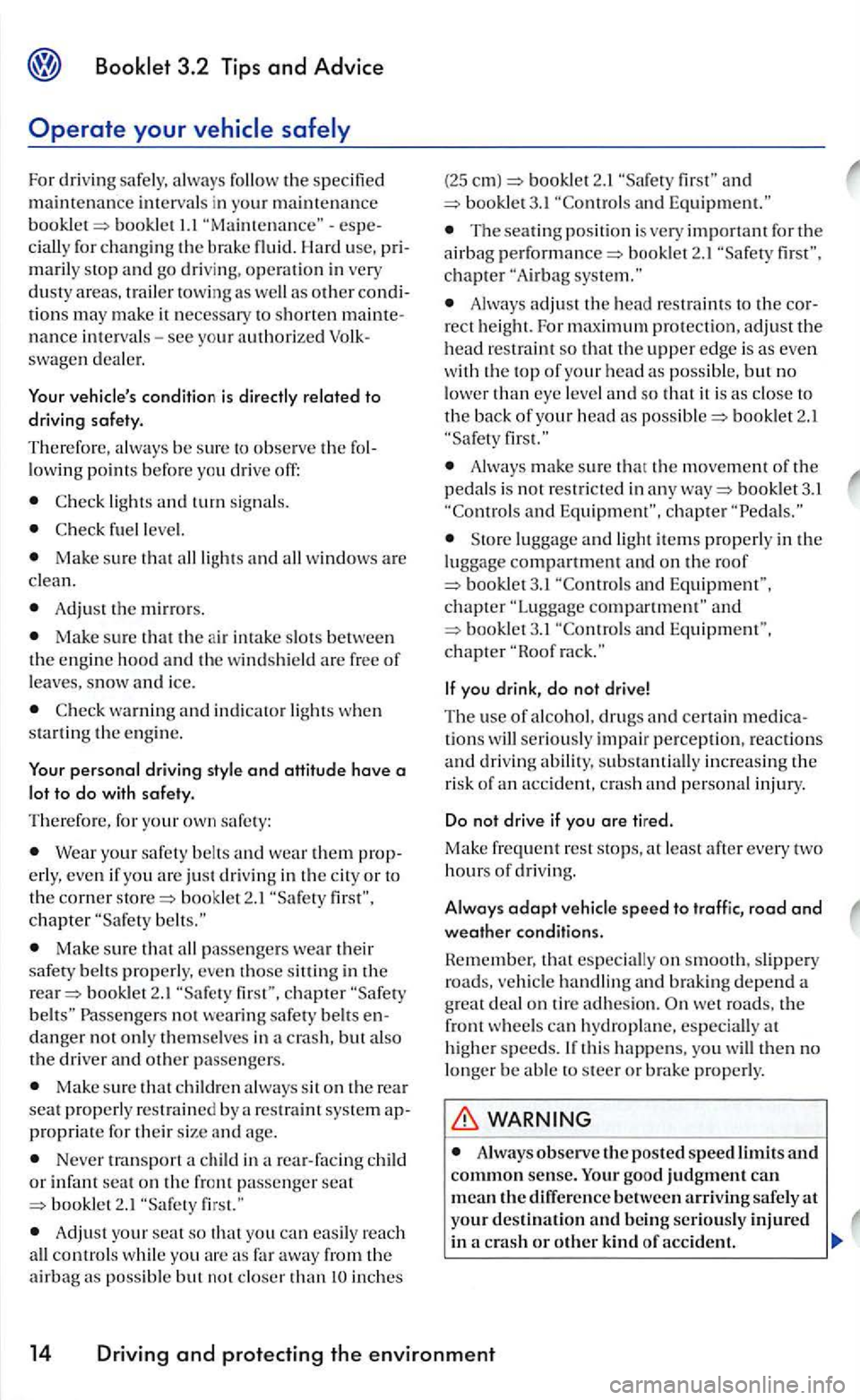
For dri ving safely. always follow the specified
maintenance int erva ls in your mainte na nce booklet 1.1 ciall y for changin g the brake fluid. Hard u se, maril y stop and go driv ing, o p eratio n in very dusty area s. trailer towing as well as other tions may make it necessary to short en nance in te rvals-see your a u th orize d swage n dealer.
Your
l ow ing po int s befo re yo u drive off:
lights and turn signal s.
Make sur e that all ligh ts and all windows are
clea n.
Adjust the mirro rs.
Make sure th at the a ir intake slots between the e ngin e hoo d and the w in d shi eld are free of leaves . s n ow and ice.
wa rnin g and indicato r light s whe n
s ta rti ng the e ng in e.
Your personal driving styl e and attitude have a
lot
to do with safety.
Th eref ore, for yo
ur ow n safety:
Wear your safety belts and wear the m
book let 2.1 chapter
Make sure that all passenge rs their safe ty be lls properly. eve n those sitting in the book le t2.1 chapter Passengers not wear ing safety bells
Make sure that chil dren always sit on the rea r seat properly restrain ed by
Neve r transport chil d in a r ear-faci ng c hild or infant seat on the fron t passe nger seat booklet2.1
Adjust you r seat that yo u can easily reach
all control s while yo u are as far away from the airbag as pos sibl e but not close r than
bookle t2.1 and bookle t3. 1
The seatin g position is ve ry important for th e
a ir bag book let2.1 chapter" Air bag
Always adjust the head rest ra int s to the rect heig ht. For maximum pro tection. adjust the
head restrai nt so the upper e d ge is as eve n
w ith the top of your head a s pos sibl e, but no lower than eye level and so that it is as close th e back of your head booklet 2.1
Always make s ure that th e movem ent of the
p ed als is not re stricted in any booklet 3.1 Equipment",
Sto re lu ggage and light it em s properly in the
lu ggage compartment and on th e roof bookle t3. 1 and Luggag e compartment " and book let3.1 and Equipment", chapte r " Roof
If you drink, do not drive!
The use of alco hol. drugs and certai n tions will seriou sly impa ir percepti on , reac tio ns and dri ving ability, substantially in creasin g the risk of an acc ident, cras h and persona l injury.
Do not driv e if you are tired.
Make frequ ent rest sto ps, least afte r every two hours of dri ving.
Always
adapt vehicle speed to traffic, rood and
weather conditions.
R e
member, that especially on sm oot h. slipp ery
roa ds, ve hicl e ha ndl ing and brak ing depend a
g reat deal o n tire adhes ion. wet roads, the
f ront w heels can h ydropla ne, especi ally at
hi ghe r speeds. th is happen s, yo u will then no
lon ger be abl e to steer or brake properly.
Alwa ys observe the p osted speed limits and common sense. good judg m ent can mean the diff ere nce b e tween arriving safely at your d estination and being seriou sly injured in a cras h or othe r kind of accident.
14 Driving and protecting the environment
Page 292 of 444
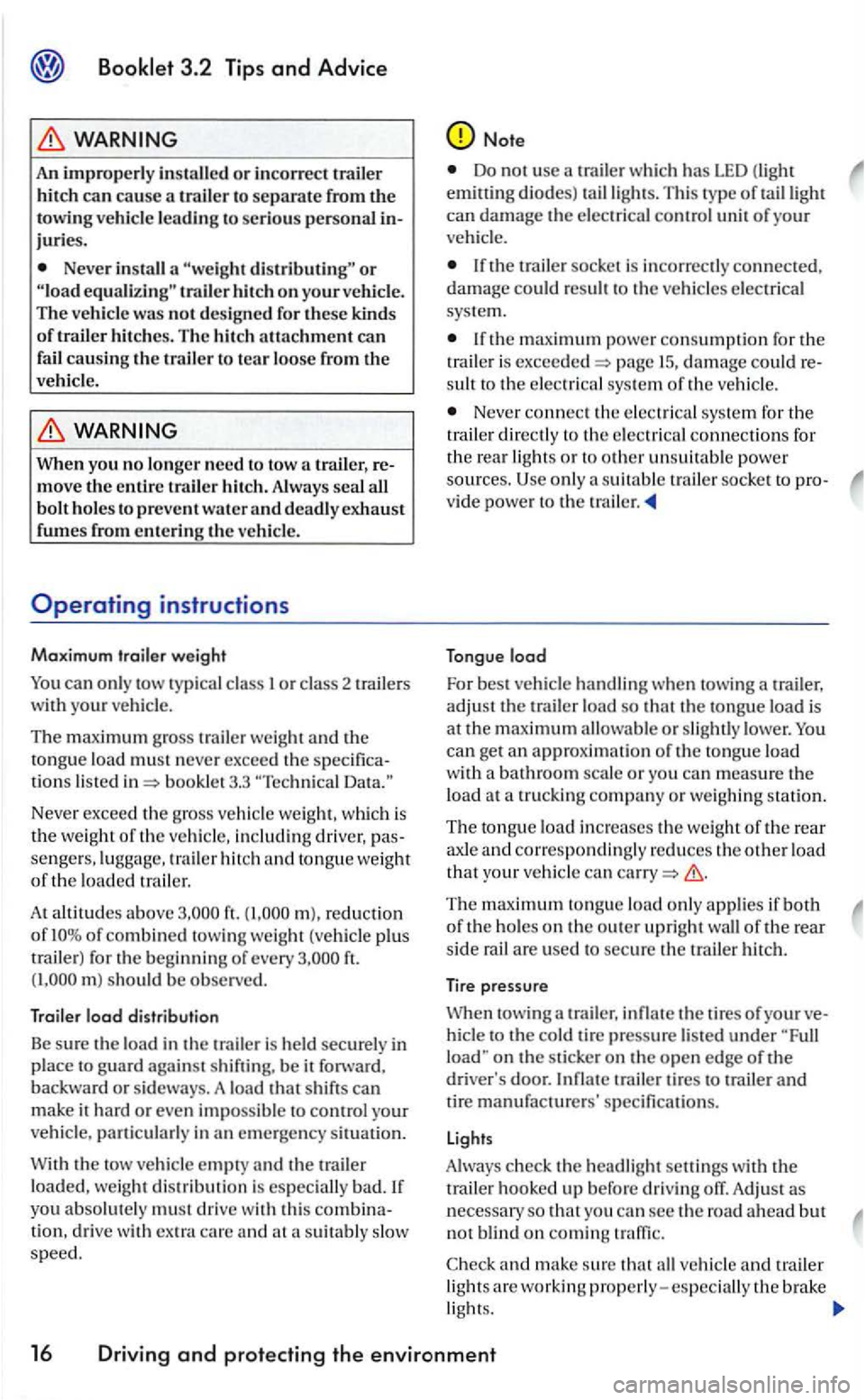
An improperly installed or incorrec t hitch from the towi ng vehicle leading to serious personal injuries.
Neve r in stall a on your vehicle . The vehicl e was not designed for these kin ds
o f trailer hitches. The hitch attachment to tear loose from the
ve hicl e.
When you n o longer need t o tow trailer, re
move the trailer hitc h . Alway s seal all bolt holes to prevent water and deadly exhaust fumes entering the ve hicle.
Operating instructions
Maximum trailer weight
You can only tow typical class I or class 2 trailers
with your vehicle.
T he m ax
imum gross trailer we ight and the tongue load must n ever exceed the specifica
tion s listed bookle t3 .3 "Tec hnical
Neve r exceed the gross ve hicl e we ight, w hi ch i s the we ight o f th e vehicle, includin g driver, passenge rs, luggage, trailer hit ch and tongu e we ight of the loaded trailer.
At alt itudes above ft. m), redu ction of of combined towin g weight (ve hicl e plu s trailer) for the beginning of every m ) should be observed.
Trailer l
oad distribution
Be sure the load in the traile r is held securel y in place to guard agains t be it forw ard.
b ackwar d or sideways. A load that shift s can make it hard or even impossibl e to control your vehicl e, parti cularly in an e m erge ncy situ ation.
W ith the tow vehicle empty and the trailer
l oade d , we ight distribution is es pecially bad. If
yo u absolut ely mus t driv e w ith this combina
tion, d rive with extra
Do not use a trailer whic h has LED (light emitting diodes) taillig ht s. This type of t a illi ght can damage the electrical co ntrol unit of your veh icle.
If the traile r socke t is in co rrectly connected .
damage co uld result to the ve hicles electrical
system.
I f th e maximum power consumption for the
trail er is pag e 15, damage could result to the e lectrica l sys te m of th e ve hicle.
Never connect the e lectr ical sys te m for th e
t raile r directly to the electrica l c o nne ctions for the rear lights or to other unsu itable power sources. Use onl y a su itab le trailer soc ket to pro
vide power to the trailer .
Tongue load
For bes t ve hicle ha ndli ng when towing a trail er, adjus t the trailer load so tha t th e tongue load is at the maximum allowable or slightly lower. You can ge t an approx imation of the to ngu e load
with a ba throom scal e or yo u can measure the load at a tru cking company or we ighing station.
The tongu e load incre ases the weigh t of the rear axle and correspondingly reduces the other load that your ve hicle ca n
The max im um tong ue load on ly a ppl ies if both of the ho les o n the o uter upright wall of th e rear side rail are used to secure the trailer hitch.
Tire pressu re
tow ing a trailer, inflate t h e tires of your ve
hicle to the col d tire press ure lis ted under on the sticker o n the open ed ge of the
dri ver's door. Inflate trailer tires to trai ler and tire manufactur ers' specificat ions.
lights
A lw ays check
the headlight settin gs wit h the tr ai le r hooked up before driving off. Adju st as n ecess ary so th a t yo u can see th e road ahead but not blind on coming
C he ck and make sur e th a t all veh icle and trailer lights are workin g properly -especially the brake light s.
16 Driving and protecting the environment
Page 293 of 444
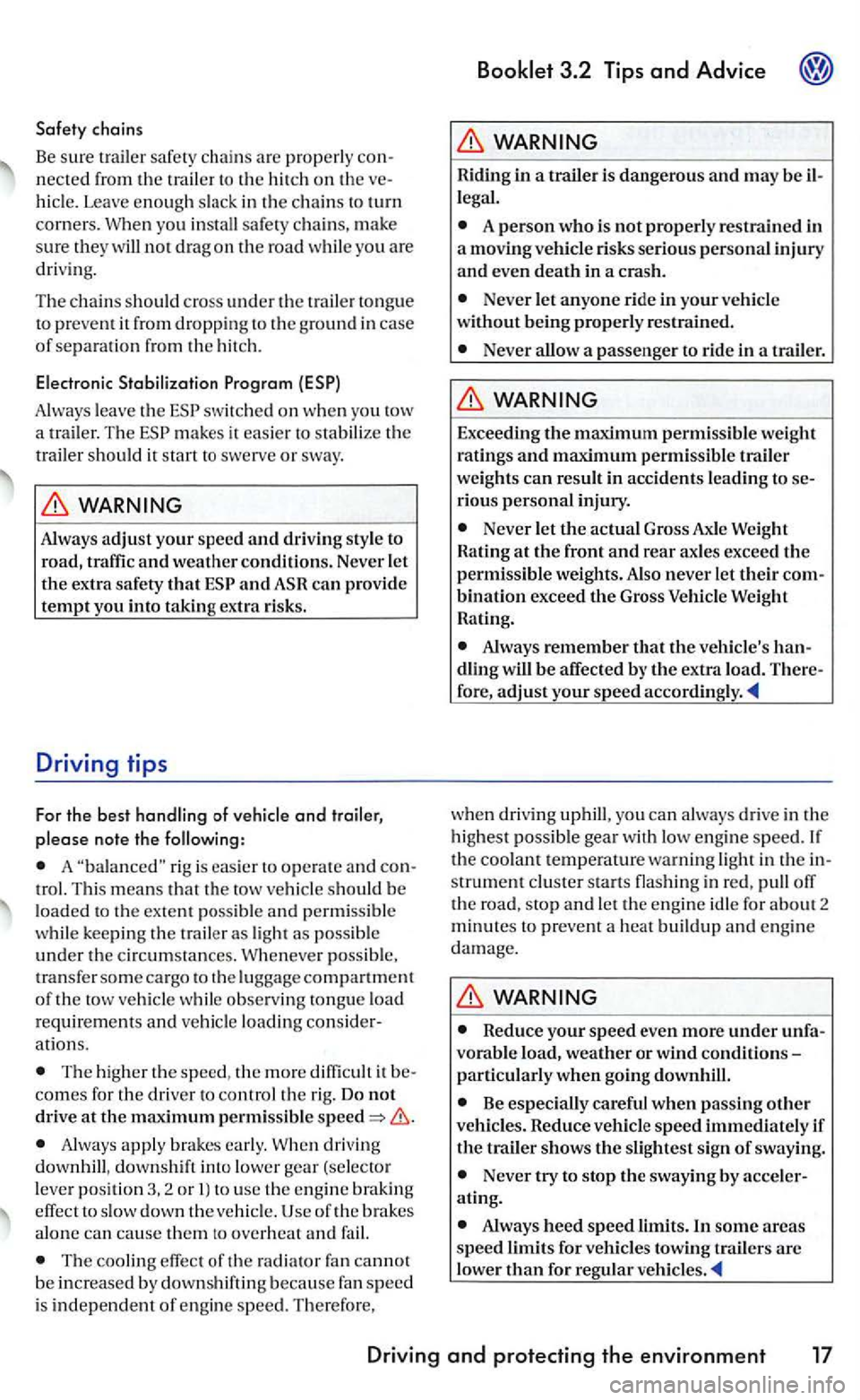
Safety chains
Be sure trailer safe ty cha ins are prop erly necte d fro m the trailer to th e hitch on th e hicle. Leave enoug h slack in th e c hain s to turn
corners. When you install safety ch a in s, mak e sure they will not dragon th e road whi le you are
driv ing.
Th e chains shou ld c ross
under th e trai le r to ng ue
to prevent it from dropping to the ground in case of separa tion from the hit ch .
Electronic Stabilization
Always leave th e mak es it easie r to stabilize the
t railer sho uld it start to swerve or sway.
Always adjust your speed and driving style to
road, traffic and weather conditions. Never le t the extra safety that and
A rig is eas ier to o pe rate and trol. Thi s means that th e tow vehicle should be loaded to the exte nt possibl e and permi ssibl e
w hil e keepin g th e t raile r as lig ht as possibl e under the ci rcumstances . Whenever possible, tran sfe r so me cargo to the luggage compartm ent
o f th e tow vehicle whil e observ ing tongue load requireme nts and ve hicl e loading ation s.
The hig her th e spee d, the more diffi cult it comes for the driver to control the rig. Do not drive at the maximum permissible
Always appl y brake s early . W hen dri ving
downhill , down shift into lower gear (selector leve r positi on
The cooli ng effect of th e fa n cannot
b e in cre ase d by dow nshif tin g because fan speed
i s independent of engine speed. Therefore,
Riding in a trailer is dangerous and may be
A person who is not properly restrained in
a moving vehicle risks serious personal injury and even death in a crash.
Never let anyone ride in your vehicle
without being properly restrained .
Never allow a passenger to rid e in a trailer.
Exceed ing the maximum permissible weight ratings and maximum permissibl e trailer
weights can result in accident s leading to rious personal injury.
Never le t the actual Gross Axle W eight Rating at the front and rear axles exceed the
permissible weights. Also never let their bination exceed the Gross Weight
Rating.
Always remember that the vehicle's
w he n dri vin g uphill, you can alwa ys drive in the
hi ghes t possibl e gear wit h low engin e speed. the coo lant tempe rature warni ng light in th e strument clu ster start s flas hin g in red, pull off
th e ro ad, s top and let th e engine idle for ab o ut 2 minutes to preve nt a heat buildup and eng in e
damage.
R educe your speed even more under vorab le load , weather or wind conditions
particularly when going downhill.
Be especial ly careful when passing other vehicles. Reduce vehicle speed immediately if the trail er shows the slightest sign of sway ing.
N ev e r try to stop the sway ing by ating.
Always heed speed limits.ln some a reas speed limits for vehicle s towing
Driving and protecting the environment 17
Page 295 of 444

is what you mus t do if you going to tow
Inse rt the trailer connector completely into the vehicle trailer socket.
Lock th e ve hicle with the remote key.
The trail er is now integ rat ed int o th e theft alarm system
For more information about the anti-theft alarm bookl et3. 1 chapter "Anti -theft Alarm
Disco nnecting your trailer from the anti-th eft
alarm system
Unlock th e vehicle with the remote key.
The anti-theft alarm sys tem is now ofT.
Note
Mod ify ing the electrical system improperly can cause expe nsive damage to the veh icle's trical sys tem. recommend yo u have your thorized Vol kswagen dealer o r qualified
driving sty le,
Co nditions of use (wea ther, road s urface) .
Technical conditions.
Think ahead when driving
A ve hicl e uses most fuel when accel erating. If
yo u think ahead when driving. you need to brake less and accelerate less. pos-
Regular servicing
B y having your vehicle serviced regularly by a authorized dealer you can es tabl is h the basis for a good fuel economy even you start drivin g. v iced e ngine give s yo u th e be nefit of better fuel
efficie ncy as well as maximum re liabilit y and greater resale value. B
y
adopting an economica l driv ing style and ticipat ing the traffic ahead, you can easily duce fuel consumption by Thi s section sug ges ts som e w ays to reduce th e impact on th e
e nvironment while reduci ng operatin g costs at
the same
s ibl e, let the vehicle roll slo wly to a stop. for
light is
A n engine that is no t properly maintained can usc up to 10% more f uel than necessary.
the oil level every time you get gas consumption dep ends la rgely on the e ngin e load and engine
Driving and protecting the environment 19
Page 302 of 444
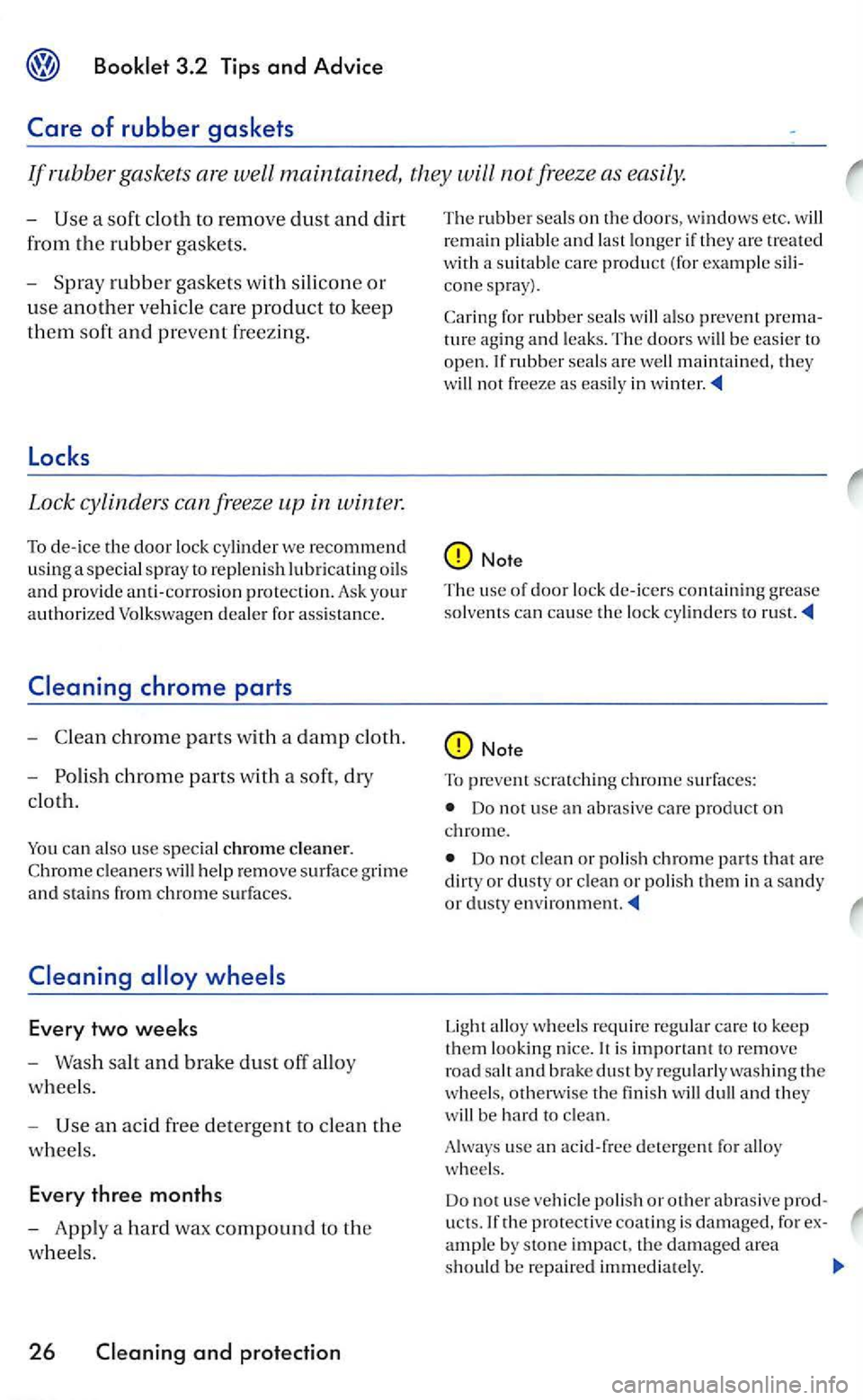
a soft cloth to re m ove dust and d irt
from
the rubber gaskets.
- Spray
rubber gaskets with silicone or
u
se another veh icle care product to kee p
them soft and p revent freez ing.
Locks
Lock cylinders can freeze up in winter.
To de-ice the door lock cylinder we recommend
using a sp e cia l spray to repl enish lubricatin g oils and pro vid e an ti- co rro sio n pro tect ion. Ask you r
authorized Volkswagen dea le r for ass istance.
ca n also use sp ecia l ch ro m e clea ner. cleaners will he lp remove surface grime and sta ins from chrome surface s.
an acid free dete rgent to clean the
w h
eels .
E very three months
- Apply a hard wax compound to the
w
heel s .
26
for rubber sea ls w ill also prevent pre mature aging and leaks. The doors will be easier to open. rubber seals are well maintained, they
will not freeze as easi ly in winter.
Note
The use of door lock de-icers contai ning grease
solvents can cause the lock cylinders to rust.
Note
To prevent scratching c hrome surface s:
Do not use an abrasive care prod uc t o n
chrome.
Do not clea n or polish chrome pa rts that are
dirty or dusty or clean or polis h them in a sandy or dusty environment.
Light alloy wheels require reg ular care to keep them look ing nice. is impor tant to remove
road salt and brake dust by regularly wash ing th e
wheels, other w ise th e finish will be hard to clean.
Always use
an acid-free detergent for alloy
w heels.
Do not use vehicle polish
or other abras ive prod
ucts. the protective coating is damaged, for example by stone im pact. the damaged area should be repaired immediately .
Page 316 of 444

WARNING (continued)
Never reach into the area around or tou ch the radiator fan. Contact w ith the blade s can resuh in se riou s personal injury. Always m ember that the radiator fan is controll ed and can turn on
m oved from the ignit ion.
Never unscrew the coolant expa nsio n tank cap when th e engin e is hot. A hot engine will heat the coo la nt and put it under pressure . mov in g a cap that i s under pressure ca n rcsuh in seriou s personal injury and/or burns.
A lway s prote ct face, hand s and arms from hot esca ping coolant or steam b y cove ring the ca p with a large, thick rag.
Turn the cap slow ly a nd very carefully in a
counter- clo ckw ise direction whil e applying
light downward pressure on the top of the cap.
Never spill on hot engine parts o r hot
e xhau st sys te m . S pilled
Neve r short-circuitthc elec trica l sys te m ,
es peciall y w here th e jumper cabl es are tached -th e balleri es could explode!
Neve r leave any objects in the e ngine partment, for exam ple cleaning rag s and too ls. Objects
Neve r work unde r the veh ic le unless you
h ave safely secured th e ve hicl e from movin g.
I f yo u must work under th e ve hicl e wit h th e
w hee ls on th e ground, always make sure the vehicl e is on leve l ground, th e wh eels arc
b locked from movin g and th e key is not in the
ignition.
Always support your ve hicle with safety
s tands if you have to wo rk underneath it. The
ja ck suppli ed with the ve hicle is not s tron g enough for this purpose and can co llap se causin g se riou s personal injury.
If you have to perform a check or r ep a ir
w hen th e e ngine is running, there arc more
ri sks from
the ro tating parts, such as the drive
WARNING (con tinued)
Neve r to uch the e lec tr ica l w ir in g of the ig ni tio n sys tem.
Always make sure that j ewe lry, loose clothing and lo ng hair do not get caught in
rota ting engine pans. Before startin g any work remove jewelry, tie back and cover
hair, and do not wear clothing that can hang down and get caught in mov ing gin e parts.
Always use extre me cauti on if the erator pedal has to be depresse d to perform
a ch eck. The vehicle could move suddenly, eve n if the parking brake is applied.
If wor k on the fu el sys te m or th e electrica l
syste m is necessa ry:
Always discon nect th e balleries. Make
sure th e vehicle is unlo cked when
Neve r sm oke .
Neve r work nea r heaters, wa te r h eaters of other open names .
A lways have an approve d fire ext guis her nearby.
To avo id electrical shock and personal jury w hil e the eng ine is running or being
s tarted :
n ever touch ignition cables,
never to uch othe r component s of the
high vohage electronic ignition syste m,
never touch the gas discharged (Xeno n) headlights wiring.
Note
Whe n chang ing or topp ing orr service fluids. make absolutel y ce rtain that you fill the fluid s
into the corr ect reservoirs. Using incorrec t fluids will resuh in serious malf unct ions and engine
damage!
For the sake of environment
Service fluid leaks are harmful to the environ-
ment. Reg ularl y check the ground undernea th
your vehicle . you find spots of oil or other
fluids. have your vehic le checked by your rized dealer or a qualified